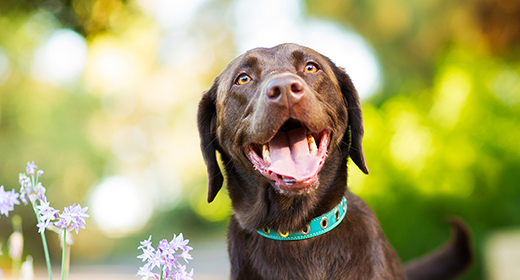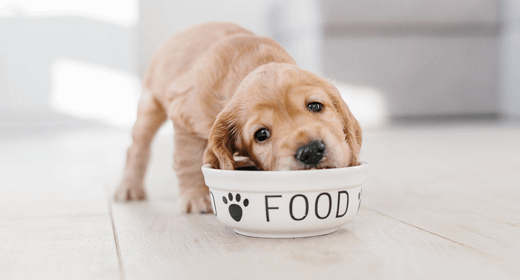

As a veterinarian, I’ve found that pet owners take seriously the responsibility of ensuring their dogs live healthy, happy lives. They worry about making sure their dog gets enough exercise, receives regular wellness checks and receives balanced nutrition that gives them energy to run and play.
What some people don’t realize is that owning and caring a dog can improve the owner’s health as well. Spending quality time with your dog and providing them with quality nutrition is good for the dog and can help ease stress and anxiety levels for you. Studies have shown that owning a pet can decrease blood pressure, cholesterol levels and triglyceride levels — which is great news for your heart health.
In short, when your dog is getting the best care, proper exercise, nutrition and love, they can enjoy a long and healthy life. And that can ultimately make you healthier, too!
Many owners see their dog as part of the family, and that sometimes means they will feed their dog like they feed themselves. For example, some people may choose low-carb or gluten-free diets for themselves and do the same for their pets. However, while this instinct comes from a place of love, many owners don’t realize that their dog’s dietary needs differ from their own.
Take grains for example. As a veterinarian, it’s important for me to note that grains are good for your dog. Yes, you read that right — they’re good!
A very small percentage of dogs may have a food sensitivity that requires a special grain-free diet or a dog food without a certain protein. However, this is not necessary for the vast majority of dogs. Most dogs benefit from a complete, balanced diet with healthy grains, high-quality proteins and essential vitamins and minerals.
Here’s why: Grains are a good source of carbohydrates that provide healthy energy. Some grains, like rice and wheat, provide “quick” energy, while other grains, like barley and sorghum, take longer to convert to energy. A combination of these different grains can offer a time-released energy source that helps dogs sustain energy. The whole grains in IAMS dog food are a beneficial mix, as they supply steady energy.
In addition to the grains you’ll find in IAMS food, you’ll also find high-quality proteins, like chicken and lamb, as well as essential nutrients needed to help support heart health. Together, this combination will give your dog a steady source of energy to be active on walks, runs, hikes or play sessions around the house.
For your dog to be healthy and happy, be sure you feed them a well-balanced diet and allow them enough exercise time. In return, you’ll get unconditional love, plenty of sweet doggy snuggles and maybe even more exercise — just a few of the ways you and your dog are joined at the heart.



Even if a pet food is formulated to provide all of the essential nutrients required by a dog, it is of little value if the animal will not eat it. Quality pet foods are carefully formulated not only to be highly nutritious but also to be highly palatable.
Highly palatable dog food recipes contain various ingredients and raw materials, including palatants. Palatants help improve the smell, flavor, and texture of your dog’s food. Examples of palatants include fat, salt, proteins, yeasts, and other flavors that are added to make food taste better. Dry foods usually need extra palatants to make them more pleasant and appealing.
Palatability is a term used to describe how well a dog likes the taste, smell, and texture of a food. A premium dog-food manufacturer spends a considerable amount of time conducting controlled feeding studies to determine the right combination of ingredients and processing techniques to produce a nutritious, palatable food.
There are two ways to test and measure the palatability of a dog food:
First Bite: The first palatability test is called the “first bite” preference. This measures the dog's first impression of a food's aroma and appearance.
Total Volume: Because the novelty of a new diet can cause highs and lows in first-bite tests, a second test is conducted called “total volume” measurement. Total volume determines the staying power or ability of a diet to maintain the animal's interest over time. This is the dog’s overall choice of a food based on taste, texture, and nutrition for the entire test period.
Dogs can become picky eaters for a variety of reasons. Some of the reasons why dogs can become picky eaters include:
In comparison to humans, dogs have significantly more smell sensors than taste receptors. This implies that foods with stronger aromas tend to appeal to dogs more. While scent is crucial, less odorous meals like dry kibble can also improve your dog’s food palatability. A dog’s taste buds are hard-wired to sense the presence of fats as well as salt (but not necessarily salt flavor). Fat is frequently added to kibble to improve flavor and palatability without making the food stinky.
While taste and scent are some of the primary ways a dog decides if something is pleasant, palatability can also be influenced by a wide range of factors, such as the dog’s unique preferences and even the owner’s preference for meals and feeding times.
To make a dog eat food, you need to:
Everybody in the household needs to accept and follow the pet’s feeding plan from the beginning. You should be consistent and rigorously adhere to your dog's diet. If you decide to give your dog leftovers, choose to combine nutritious foods with kibble.
Offering your dog table scraps often promotes begging and throws off your pet’s diet. It can also lead to several health issues, including diarrhea and pancreatitis. Although human food is far more palatable, it is less healthy than canned or dry dog food.
Puppies need to be fed two to three times a day, or as your vet may prescribe. As they get older, you can gradually increase the serving size while offering meals just once or twice a week. Additionally, you must add some variety and deliver equal servings.

In order to obtain and interpret accurate results, palatability studies must be performed by experienced animal technicians and the data analyzed by research nutritionists. Feeding studies are conducted by offering an animal two bowls of food at the same time. Each bowl contains a different diet that has been carefully weighed and recorded.
The technician observes which food the dog chooses to eat first, and then records that as the first-bite preference. After a specific time period, bowls are removed, and any remaining food is weighed and recorded. Diets also are switched from left to right each day of the study to ensure that dogs are not eating one diet simply out of habit.
The total-volume measurement is determined by calculating the difference between the beginning and ending weights of each food. This procedure is repeated using the same two diets with the same group of dogs for five days. At the end of the five-day study, all observations and data are compiled and analyzed to determine the overall palatability of each diet.
Here is a quick look at some flavors that can appeal to your pet.
Meaty Flavor
Animal Fats
Gravy or Stews
Dogs are attracted by not only the taste of a food, but also to its sight, aroma, and texture. Dogs are particularly interested in the smell of food.
If you are wondering how to increase palatability of dog food, here are a few tips that might help.
Whether your pooch prefers dry or wet dog food, remember that the choice of protein is extremely essential. The most palatable dog foods are ones that are available in different meaty flavors such as lamb, beef, and chicken.
By adding fats, salts, and other additives, dry dog foods are made more palatable. Additionally, fats contribute a softer taste to the food which dogs tend to enjoy. In fact, canines find fats to be tasty and will actively seek this flavor in their meals. While the aim is to serve highly palatable dog food to your pet, do be sure to check the right amount of fat content with the veterinarian./p>
Another strategy for improving the taste of food is to add food additives. These can be actual meats that the dog owner adds to the dish such as boiled turkey or any flavored store-bought gravies.
Since many supplements aim to increase the nutritional value of food, they may include ingredients that are disliked by dogs. Try introducing liquid or soft treats to make dog food more palatable. There are also certain supplements which are tasty by nature. These can be used to enhance the flavor of dog food while maintaining nutritional value.
Liquid digest is simply protein that is enzymatically broken down into amino acids, which are the building blocks of protein. The enzymatic process reduces large protein pieces to smaller protein pieces and free amino acids. By adding small amounts of acid, the enzymatic or digestive reaction is stopped, and a stable liquid ingredient is produced. After a dry-food formula is cooked, formed into kibbles, and dried, the liquid digest is sprayed evenly on the outside of the dry kibbles. This is called “enrobing.” Not only does the liquid digest make the food highly palatable, but it also adds to the overall digestibility of the food.
Yes. We use liquid digest made from chicken to enhance the palatability of dry foods and to contribute to the nutritional value of the diet. Some pet foods include flavor enhancers, such as onion powder, which simply mask the aroma and taste of the ingredients and provide no nutritional benefits to the animal.